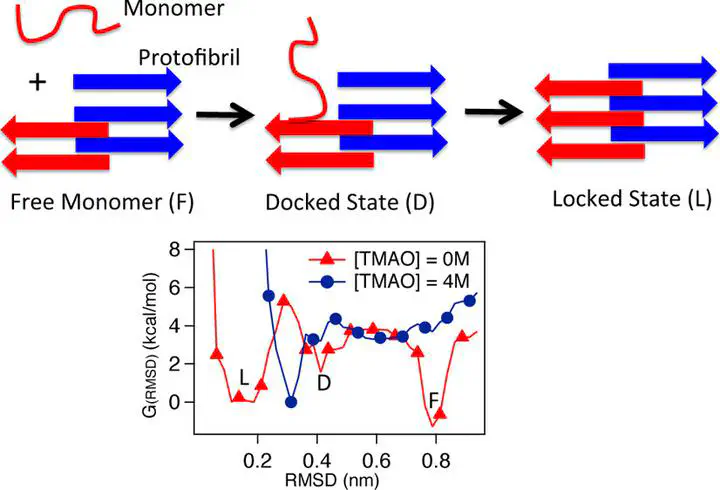 Image credit: G. Reddy
Image credit: G. Reddy
Abstract
Understanding the role of naturally occurring protective osmolytes, such as trimethylamine N-oxide (TMAO), in the growth of amyloid fibrils implicated in neurodegenerative diseases is important to prevent fibril growth. The effect of TMAO on the growth of amyloid fibrils formed by the Sup35 prion peptide NNQQNY is studied using molecular dynamics simulations. The free-energy surface for the growth of the protofibril shows three major basins, corresponding to the free state where the peptide is in solution, the docked state where the peptide in solution interacts with the surface of the protofibril, and the locked state where the peptide is tightly bound to the protofibril, becoming a part of the fibril. The free-energy surface in the presence of TMAO shows that TMAO stabilizes the locked state of the peptide compared with the free state, indicating that TMAO aids in fibril growth. Dissecting the interaction of TMAO with individual amino acids in the peptide shows that TMAO interacts both directly and indirectly with the amino acids, depending on the nature of the side chains. The methyl groups in TMAO interact strongly with the hydrophobic aromatic ring in the Tyr residue. In the locked state, the surface area of Tyr available for interaction with TMAO decreases; as a result, the Tyr residue in the peptide flips out from the locked position, increasing the fluctuations of the peptide locked in the protofibril. Such strong direct interactions of amino acids with TMAO destabilize the folded or aggregated states of proteins. The overall increased stability of the peptide locked in the protofibril by TMAO is due to entropic or indirect interactions with the backbone Asn and Gln residues, which form major components of the NNQQNY peptide.